
In this section you will:

It is not easy to make the honor role at most top universities. Suppose students were required to carry a course load of at least 12 credit hours and maintain a grade point average of 3.5 or above. How could these honor roll requirements be expressed mathematically? In this section, we will explore various ways to express different sets of numbers, inequalities, and absolute value inequalities.
Indicating the solution to an inequality such as
can be achieved in several ways.
We can use a number line as shown in [link]. The blue ray begins at
and, as indicated by the arrowhead, continues to infinity, which illustrates that the solution set includes all real numbers greater than or equal to 4.

We can use set-builder notation:
which translates to “all real numbers x such that x is greater than or equal to 4.” Notice that braces are used to indicate a set.
The third method is interval notation, in which solution sets are indicated with parentheses or brackets. The solutions to
are represented as
This is perhaps the most useful method, as it applies to concepts studied later in this course and to other higher-level math courses.
The main concept to remember is that parentheses represent solutions greater or less than the number, and brackets represent solutions that are greater than or equal to or less than or equal to the number. Use parentheses to represent infinity or negative infinity, since positive and negative infinity are not numbers in the usual sense of the word and, therefore, cannot be “equaled.” A few examples of an interval, or a set of numbers in which a solution falls, are
or all numbers between
and
including
but not including
all real numbers between, but not including
and
and
all real numbers less than and including
[link] outlines the possibilities.
| Set Indicated | Set-Builder Notation | Interval Notation |
|---|---|---|
| All real numbers between a and b, but not including a or b |
| All real numbers greater than a, but not including a |
| All real numbers less than b, but not including b |
| All real numbers greater than a, including a |
| All real numbers less than b, including b |
| All real numbers between a and b, including a |
| All real numbers between a and b, including b |
| All real numbers between a and b, including a and b |
| All real numbers less than a or greater than b |
| All real numbers |
| {: #Table_02_07_01 summary=”A table with 11 rows and 3 columns. The entries in the first row are: Set Indicated, Set-Builder Notation, Interval Notation. The entries in the second row are: All real numbers between a and b, but not including a and b; {x | a x b}; (a,b). The entries in the third row are: All real numbers greater than a, but not including a; {x | x a}; (a , infinity). The entries in the fourth row are: All real numbers less than b, but not including b; {x | x b}; (negative infinity, b). The entries in the fifth row are: All real numbers greater than a, including a; {x | x a}; [a, infinity). The entries in the sixth row are: All real numbers less than b, including b; {x | x b}; (negative infinity, b]. The entries in the seventh row are: All real numbers between a and b, including a; {x | a x b}; [a, b). The entries in the eighth row are: All real numbers between a and b, including b; {x | a x b}; (a, b]. The entries in the ninth row are: All real numbers between a and b, including a and b; {x | a x b}; [a, b]. The entries in the tenth row are: all real numbers less than a or greater than b; {x | x a or x b}; (negative infinity, a) union (b, infinity). The entries in the eleventh row are: All real numbers; {x | x is all real numbers}; (negative infinity, infinity).”} |
Use interval notation to indicate all real numbers greater than or equal to
Use a bracket on the left of
and parentheses after infinity:
The bracket indicates that
is included in the set with all real numbers greater than
to infinity.
Use interval notation to indicate all real numbers between and including
and
Write the interval expressing all real numbers less than or equal to
or greater than or equal to
We have to write two intervals for this example. The first interval must indicate all real numbers less than or equal to 1. So, this interval begins at
and ends at
which is written as
The second interval must show all real numbers greater than or equal to
which is written as
However, we want to combine these two sets. We accomplish this by inserting the union symbol,
between the two intervals.
Express all real numbers less than
or greater than or equal to 3 in interval notation.
When we work with inequalities, we can usually treat them similarly to but not exactly as we treat equalities. We can use the addition property and the multiplication property to help us solve them. The one exception is when we multiply or divide by a negative number; doing so reverses the inequality symbol.
These properties also apply to
and
Illustrate the addition property for inequalities by solving each of the following:
The addition property for inequalities states that if an inequality exists, adding or subtracting the same number on both sides does not change the inequality.
Solve:
Illustrate the multiplication property for inequalities by solving each of the following:
Solve:
As the examples have shown, we can perform the same operations on both sides of an inequality, just as we do with equations; we combine like terms and perform operations. To solve, we isolate the variable.
Solve the inequality:
Solving this inequality is similar to solving an equation up until the last step.
The solution set is given by the interval
or all real numbers less than and including 1.
Solve the inequality and write the answer using interval notation:
Solve the following inequality and write the answer in interval notation:
We begin solving in the same way we do when solving an equation.
The solution set is the interval
Solve the inequality and write the answer in interval notation:
A compound inequality includes two inequalities in one statement. A statement such as
means
and
There are two ways to solve compound inequalities: separating them into two separate inequalities or leaving the compound inequality intact and performing operations on all three parts at the same time. We will illustrate both methods.
Solve the compound inequality:
The first method is to write two separate inequalities:
and
We solve them independently.
Then, we can rewrite the solution as a compound inequality, the same way the problem began.
In interval notation, the solution is written as
The second method is to leave the compound inequality intact, and perform solving procedures on the three parts at the same time.
We get the same solution:
Solve the compound inequality:
Solve the compound inequality with variables in all three parts:
Let’s try the first method. Write two inequalities:
The solution set is
or in interval notation
Notice that when we write the solution in interval notation, the smaller number comes first. We read intervals from left to right, as they appear on a number line. See [link].

Solve the compound inequality:
As we know, the absolute value of a quantity is a positive number or zero. From the origin, a point located at
has an absolute value of
as it is x units away. Consider absolute value as the distance from one point to another point. Regardless of direction, positive or negative, the distance between the two points is represented as a positive number or zero.
An absolute value inequality is an equation of the form
Where A, and sometimes B, represents an algebraic expression dependent on a variable x. Solving the inequality means finding the set of all
-values that satisfy the problem. Usually this set will be an interval or the union of two intervals and will include a range of values.
There are two basic approaches to solving absolute value inequalities: graphical and algebraic. The advantage of the graphical approach is we can read the solution by interpreting the graphs of two equations. The advantage of the algebraic approach is that solutions are exact, as precise solutions are sometimes difficult to read from a graph.
Suppose we want to know all possible returns on an investment if we could earn some amount of money within $200 of $600. We can solve algebraically for the set of x-values such that the distance between
and 600 is less than 200. We represent the distance between
and 600 as
and therefore,
or
This means our returns would be between $400 and $800.
To solve absolute value inequalities, just as with absolute value equations, we write two inequalities and then solve them independently.
For an algebraic expression X, and
an absolute value inequality is an inequality of the form
These statements also apply to
and
Describe all values
within a distance of 4 from the number 5.
We want the distance between
and 5 to be less than or equal to 4. We can draw a number line, such as in [link], to represent the condition to be satisfied.

The distance from
to 5 can be represented using an absolute value symbol,
Write the values of
that satisfy the condition as an absolute value inequality.
We need to write two inequalities as there are always two solutions to an absolute value equation.
If the solution set is
and
then the solution set is an interval including all real numbers between and including 1 and 9.
So
is equivalent to
in interval notation.
Describe all x-values within a distance of 3 from the number 2.
Solve
.
Given the equation
determine the x-values for which the y-values are negative.
We are trying to determine where
which is when
We begin by isolating the absolute value.
Next, we solve for the equality
Now, we can examine the graph to observe where the y-values are negative. We observe where the branches are below the x-axis. Notice that it is not important exactly what the graph looks like, as long as we know that it crosses the horizontal axis at
and
and that the graph opens downward. See [link].
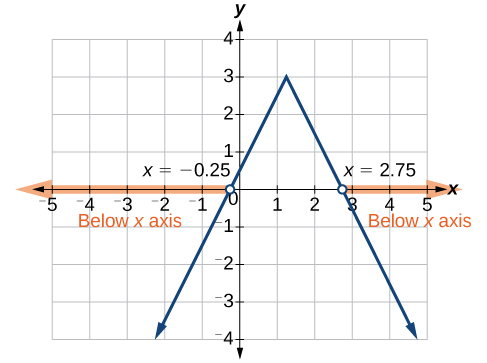
Solve
or
in interval notation, this would be
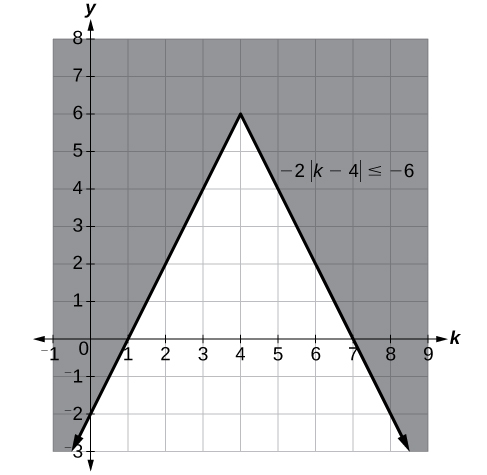
Access these online resources for additional instruction and practice with linear inequalities and absolute value inequalities.
When solving an inequality, explain what happened from Step 1 to Step 2:
When we divide both sides by a negative it changes the sign of both sides so the sense of the inequality sign changes.
When solving an inequality, we arrive at:
Explain what our solution set is.
When writing our solution in interval notation, how do we represent all the real numbers?
When solving an inequality, we arrive at:
Explain what our solution set is.
Describe how to graph
We start by finding the x-intercept, or where the function = 0. Once we have that point, which is
we graph to the right the straight line graph
and then when we draw it to the left we plot positive y values, taking the absolute value of them.
For the following exercises, solve the inequality. Write your final answer in interval notation.
For the following exercises, solve the inequality involving absolute value. Write your final answer in interval notation.
All real numbers
No solution
For the following exercises, describe all the x-values within or including a distance of the given values.
Distance of 5 units from the number 7
Distance of 3 units from the number 9
Distance of10 units from the number 4
Distance of 11 units from the number 1
For the following exercises, solve the compound inequality. Express your answer using inequality signs, and then write your answer using interval notation.
For the following exercises, graph the function. Observe the points of intersection and shade the x-axis representing the solution set to the inequality. Show your graph and write your final answer in interval notation.
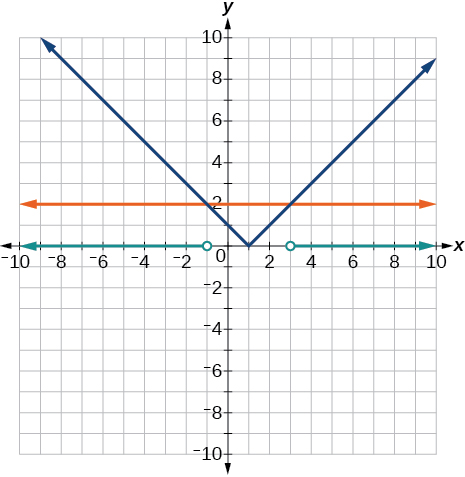
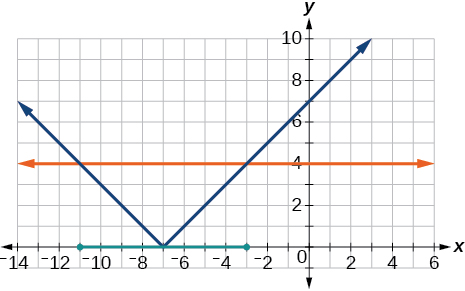
It is never less than zero. No solution.
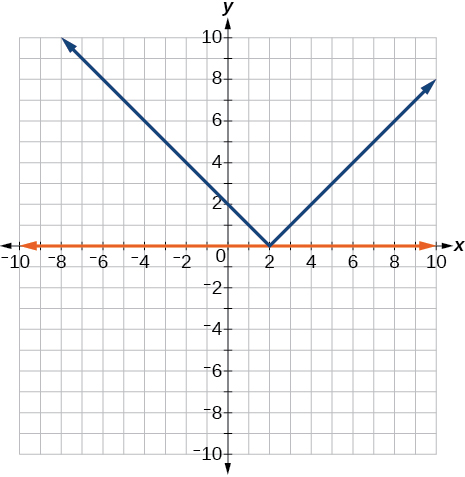
For the following exercises, graph both straight lines (left-hand side being y1 and right-hand side being y2) on the same axes. Find the point of intersection and solve the inequality by observing where it is true comparing the y-values of the lines.
Where the blue line is above the orange line; point of intersection is
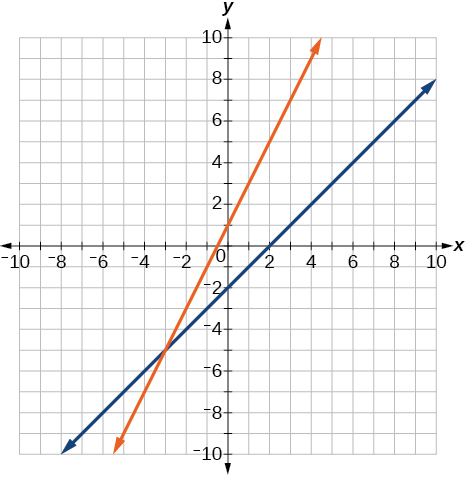
Where the blue line is above the orange line; always. All real numbers.
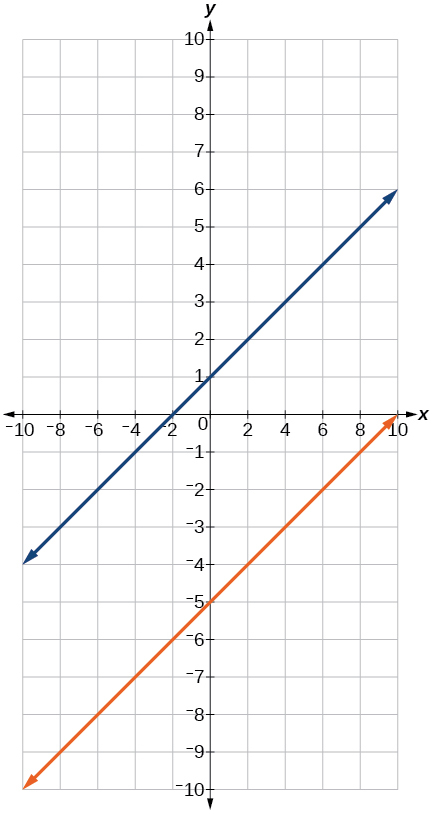
For the following exercises, write the set in interval notation.
For the following exercises, write the interval in set-builder notation.
For the following exercises, write the set of numbers represented on the number line in interval notation.
For the following exercises, input the left-hand side of the inequality as a Y1 graph in your graphing utility. Enter y2 = the right-hand side. Entering the absolute value of an expression is found in the MATH menu, Num, 1:abs(. Find the points of intersection, recall (2nd CALC 5:intersection, 1st curve, enter, 2nd curve, enter, guess, enter). Copy a sketch of the graph and shade the x-axis for your solution set to the inequality. Write final answers in interval notation.
Where the blue is below the orange; always. All real numbers.
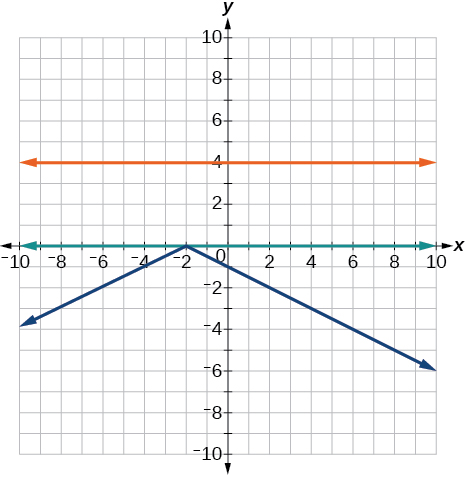
Where the blue is below the orange;
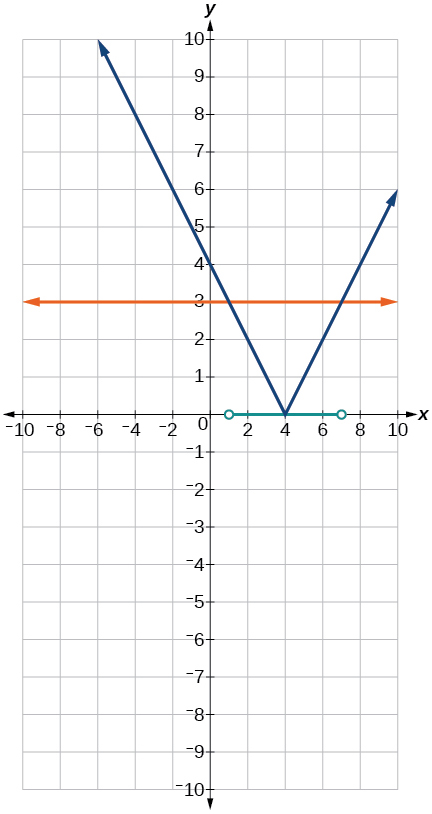
Solve
Solve
is a profit formula for a small business. Find the set of x-values that will keep this profit positive.
In chemistry the volume for a certain gas is given by
where V is measured in cc and T is temperature in ºC. If the temperature varies between 80ºC and 120ºC, find the set of volume values.
A basic cellular package costs $20/mo. for 60 min of calling, with an additional charge of $.30/min beyond that time.. The cost formula would be
If you have to keep your bill lower than $50, what is the maximum calling minutes you can use?
For the following exercises, find the x-intercept and the y-intercept without graphing.
x-intercept:
y-intercept:
For the following exercises, solve for y in terms of x, putting the equation in slope–intercept form.
For the following exercises, find the distance between the two points.
Find the distance between the two points
and
using your calculator, and round your answer to the nearest thousandth.
For the following exercises, find the coordinates of the midpoint of the line segment that joins the two given points.
midpoint is
For the following exercises, construct a table and graph the equation by plotting at least three points.
| x | y |
| 0 | −2 |
| 3 | 2 |
| 6 | 6 |
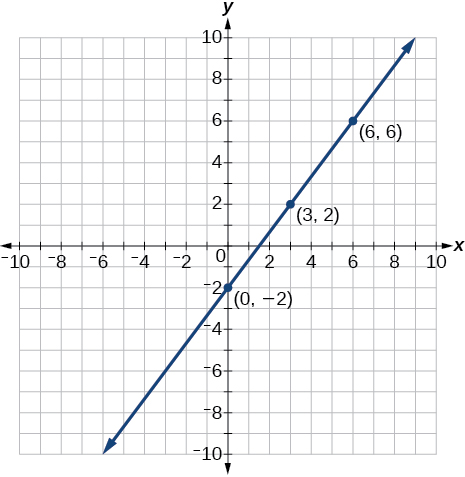
For the following exercises, solve for
For the following exercises, solve for
State all x-values that are excluded from the solution set.
No solution
For the following exercises, find the equation of the line using the point-slope formula.
Passes through these two points:
Passes through the point
and has a slope of
Passes through the point
and is parallel to the graph
Passes through these two points:
For the following exercises, write and solve an equation to answer each question.
The number of males in the classroom is five more than three times the number of females. If the total number of students is 73, how many of each gender are in the class?
females 17, males 56
A man has 72 ft. of fencing to put around a rectangular garden. If the length is 3 times the width, find the dimensions of his garden.
A truck rental is $25 plus $.30/mi. Find out how many miles Ken traveled if his bill was $50.20.
84 mi
For the following exercises, use the quadratic equation to solve.
For the following exercises, name the horizontal component and the vertical component.
horizontal component
vertical component
For the following exercises, perform the operations indicated.
For the following exercises, solve the quadratic equation by factoring.
For the following exercises, solve the quadratic equation by using the square-root property.
For the following exercises, solve the quadratic equation by completing the square.
For the following exercises, solve the quadratic equation by using the quadratic formula. If the solutions are not real, state No real solution.
For the following exercises, solve the quadratic equation by the method of your choice.
For the following exercises, solve the equations.
For the following exercises, solve the inequality. Write your final answer in interval notation.
No solution
For the following exercises, solve the compound inequality. Write your answer in interval notation.
For the following exercises, graph as described.
Graph the absolute value function and graph the constant function. Observe the points of intersection and shade the x-axis representing the solution set to the inequality. Show your graph and write your final answer in interval notation.
Graph both straight lines (left-hand side being y1 and right-hand side being y2) on the same axes. Find the point of intersection and solve the inequality by observing where it is true comparing the y-values of the lines. See the interval where the inequality is true.
Where the blue is below the orange line; point of intersection is
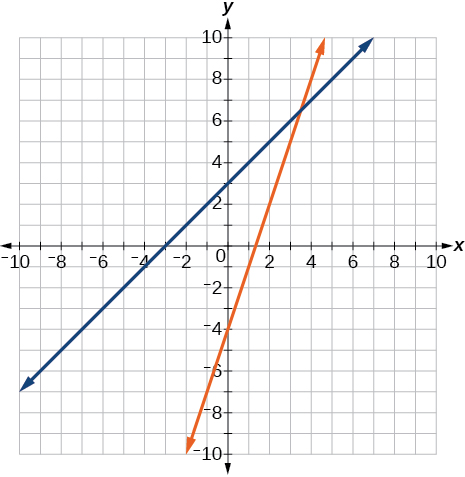
Graph the following:
| x | y |
|---|---|
| 0 | 2 |
| 2 | 5 |
| 4 | 8 |
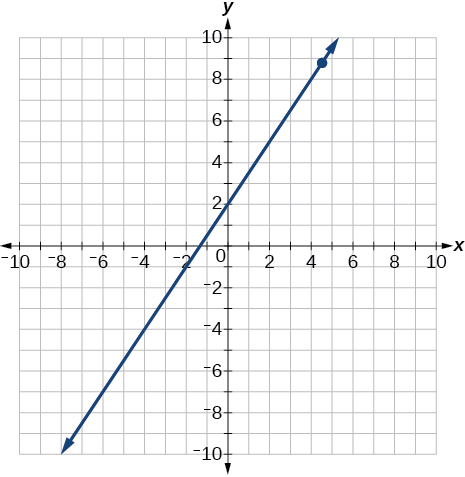
Find the x- and y-intercepts for the following:
Find the x- and y-intercepts of this equation, and sketch the graph of the line using just the intercepts plotted.
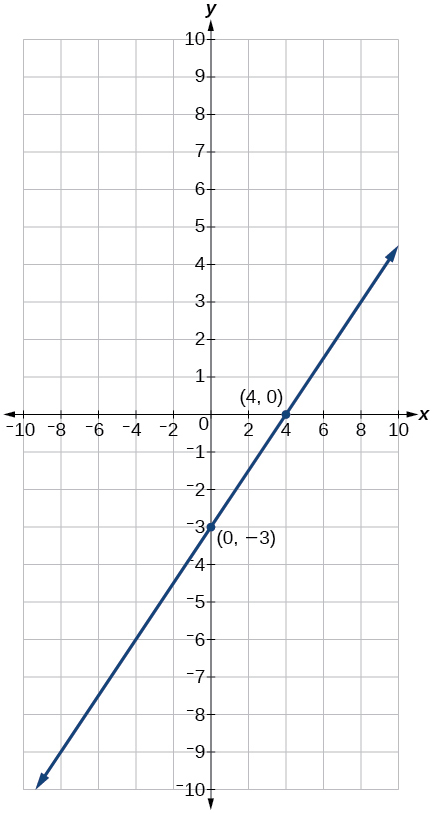
Find the exact distance between
and
Find the coordinates of the midpoint of the line segment joining the two points.
Write the interval notation for the set of numbers represented by
Solve for x:
Solve for x:
Solve for x:
Solve for x:
The perimeter of a triangle is 30 in. The longest side is 2 less than 3 times the shortest side and the other side is 2 more than twice the shortest side. Find the length of each side.
Solve for x. Write the answer in simplest radical form.
Solve:
Solve:
Solve:
For the following exercises, find the equation of the line with the given information.
Passes through the points
and
Has an undefined slope and passes through the point
Passes through the point
and is perpendicular to
Add these complex numbers:
Simplify:
Multiply:
Divide:
Solve this quadratic equation and write the two complex roots in
form:
Solve:
Solve:
Solve:
Solve:
Solve:
Solve:
For the following exercises, find the real solutions of each equation by factoring.

You can also download for free at http://cnx.org/contents/13ac107a-f15f-49d2-97e8-60ab2e3b519c@11.1
Attribution: